
Madan Puraskār Pustakālaya is a library of books and periodicals in the Nepali language. The library is a not-for-profits and non-governmental institution that is run by a trust. In addition to the archive, the library is involved in many other areas like publishing, educational training and development of information technology in Nepali language. The library also manages Madan Puraskar and Jagadamba Shree Purasakar prizes.

The Rastrapati Bhawan is the official residence of the President of Nepal, located in Kathmandu, Nepal. It hosts the Office of The President of Nepal. The main palace building is also known as Shital Niwas. It was built by Rana Prime Minister Chandra Shumsher JBR in 1923.
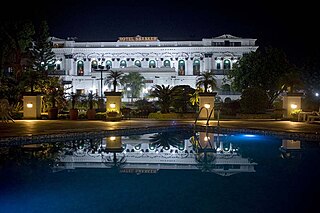
Lazimpat is a residential area of Kathmandu, the capital city of Nepal. It is close to the Narayanhity Palace, and is well known in Kathmandu for its hotels, restaurants, schools, colleges, embassies and department stores. The neighborhood's name derives from Lazimpat Durbar, that lies in its vicinity and was converted into Hotel Shanker.

The Narayanhiti Palace Museum is a public museum in Kathmandu, Nepal located east of the Kaiser Mahal and next to Thamel. The museum was created in 2008 from the complex of the former Narayanhiti Palace following the 2006 revolution. Before the revolution, the palace was the residence and principal workplace of the monarch of the Kingdom of Nepal, and hosted occasions of state.
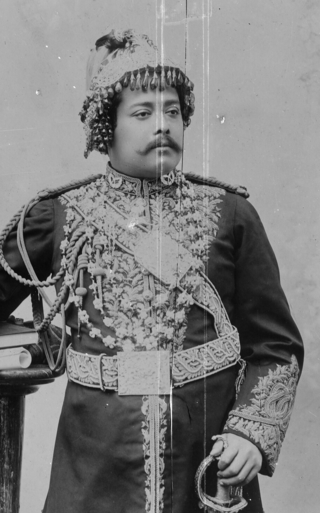
Sri Maharaja, Dev Shumsher Jung Bahadur Rana was the Prime Minister of Nepal for 114 days in 1901. He was also the King of Lamjung and Kaski.
Jāwalākhel is a subdivision of Lalitpur in Nepal. It is located 2 km from the ancient city centre Pātan, one of the three great capitals of Nepal until the 18th century. It derives its name from Jaulakhel Durbar, a palace located in Jawalakhel that was built by Bir Shumsher Jang Bahadur Rana in 1954 BS.
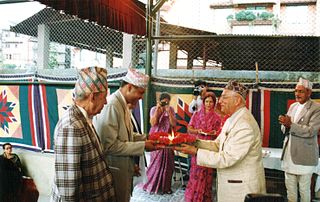
The Madan Puraskar is a literary honor in Nepal which Madan Puraskar Guthi confers annually for an outstanding book in the Nepali language published within the calendar year. It is considered the most prestigious literature award in Nepal. It is awarded on the day of Ghatasthapana every year alongside Jagadamba Shree Puraskar.
Jagadamba Shree Puraskar is an award given for contribution to Nepali Language, Literature, Art and Folk Culture Field. It is awarded to a person or an organization who has contributed in the field of Nepali language, literature, art or folk culture fields.

Thapathali Durbar was a palace complex in Kathmandu, the capital of Nepal. Thapathali means abode of the Thapas. It was initially built by Nain Singh Thapa of the Thapa dynasty but was later occupied by Jung Bahadur Rana, as prime minister, the executive head of Nepal. The palace complex, located north of the Bagmati river, encompasses an impressive and vast array of courtyards, gardens, and buildings. Many palaces and buildings were built throughout late 1840s to 1900, initially by Nain Singh Thapa, a member of the aristocratic Thapa family and brother of Bhimsen Thapa, and later was acquired by Nain Singh Thapa's grandson Jung Bahadur Rana. Further additions were made by successive Ranas up to the 19th century.

Kaiser Mahal is a Rana palace in Kathmandu, the capital of Nepal. The palace complex, located west of the Narayanhity Palace, was incorporated in an impressive and vast array of courtyards, gardens and buildings.

Lal Durbar is a Rana palace in Kathmandu, the capital of Nepal. The palace complex, located East of the Narayanhity Palace, was incorporated in an impressive and vast array of courtyards, gardens and buildings. Lal Durbar was built by Bir Shamsher JBR in 1890 CE.

Seto Durbar was a Rana palace in Kathmandu, the capital of Nepal. The palace complex, located south of the Narayanhity Palace, was incorporated in an impressive and vast array of courtyards, furnishings and guest halls. Seto Durbar was built by Bir Shumsher Jung Bahadur Rana in 1893 CE.
Jaulakhel Durbar was a Rana palace in Jawalakhel, Lalitpur, the capital city of Nepal. Jaulakhel Durbar was built by Bir Shumsher Jang Bahadur Rana in 1954 BS.
Lakshmi Niwas is a Rana palace in Maharajgunj, Kathmandu, the capital of Nepal. The palace complex, located north of the Bagmati river, was incorporated in an impressive and vast array of courtyards, gardens and buildings. It was built by Chandra Shumsher JBR, at the time prime minister and the executive leader of Nepal.
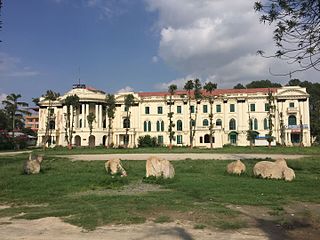
Sita Bhawan is a Rana palace in Kathmandu, the capital of Nepal. The palace complex, located East of the Narayanhity Palace, was incorporated in an impressive and vast array of courtyards, gardens and buildings. Sita Bhawan was built by Bhim Shamsher Jang Bahadur Rana in 1929 for his wife Her Highness Sri Teen Sita Bada Maharani Deela Kumari Devi.
Bhatbhateni Durbar was a Rana palace in Kathmandu, Nepal. The palace complex, located in Hadigau, was incorporated in an impressive and vast array of courtyards, furnishings and guest halls. Bhatbhateni Durbar was built by Bir Shumsher JBR in 1888.

Harihar Bhawan is a Rana palace in Patan, Nepal the capital of the Nepal. The palace complex, located west of the Shree Durbar, was incorporated in an impressive and vast array of courtyards, gardens and buildings.

Shree Durbar is a Rana palace in Kathmandu, Patan, Nepal the capital of Nepal. The palace complex, located east of the Lazimpat Durbar next to Patan Dhoka, was incorporated in an impressive and vast array of courtyards, gardens and buildings. Sri Durbar was built by Chandra Shumsher JBR in 1927.
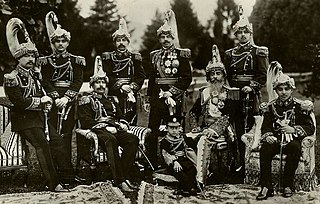
Major General Madan Shumsher Jung Bahadur Rana was a Nepalese cricketer and son of 13th Prime Minister of Nepal Chandra Shumsher JBR.

Jagadamba Nepali Dharamshala is a Nepali Dharamshala in Varanasi, India. Established in 1960 by a single donation of Rani Jagadamba Kumari Devi, wife of Lt.-Gen. Madan Shumsher JBR. Jagadamba Nepali Dharamshala provides basic accommodation at a minimal cost. It is currently run by Vidya Dharma Pracharini Nepali Samiti, a committee made up of Nepali people living in Varanasi.



















